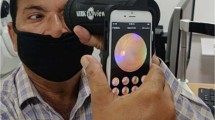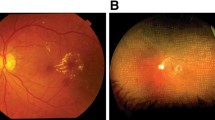Abstract
Aims
To summarize the effects of centralization of diabetic fundus photograph interpretation into a virtual reading center.
Methods
In 2016 Kaiser Permanente Northern California, a large, membership-based health plan with an ethnically and racially diverse population, centralized diabetic retinopathy screening into a virtual reading center. Retina screens were based on single field, 45-degree fundus photographs. We compared the accuracy of photography interpretation the year before centralization to the year after using masked reads performed by retina specialists of 1000 randomly selected screens from each time period.
Results
In all, 1902 patient screens with adequate quality images were included in the primary analysis. Images from pre-centralization screens were largely read by ophthalmologists (76.2%), while screens post-centralization were mainly read by optometrists (84.6%). Despite being interpreted by readers with lower levels of professional training, the sensitivity of screening increased from 43.9% (95% CI 38.0–49.8%) to 66.0% (95% CI 60.5–71.4%).
Conclusion
A move to a centralized virtual reading center was associated with improved accuracy of diabetic retinopathy screening.

Similar content being viewed by others
References
Lee R, Wong TY, Sabanayagam C (2015) Epidemiology of diabetic retinopathy, diabetic macular edema and related vision loss. Eye Vis 2:1–25
Ogurtsova K, da Rocha Fernandes JD, Huang Y et al (2017) Global estimates for the prevalence of diabetes for 2015 and 2040. Diabetes Res Clin Pract 128:40–50
Diabetes Report, National Eye Institute (2010) https://nei.nih.gov/eyedata/diabetic. Accessed 29 June 2019
Yau JW, Rogers SL, Kawasaki R et al (2012) Global prevalence and major risk factors of diabetic retinopathy. Diabetes Care 35:556–564
Wu L, Fernandez-Loiaza P, Sauma J et al (2013) Classification of diabetic retinopathy and diabetic macular edema. World J Diabetes 4:290–294
Olayiwola JN, Sobieraj DM, Kulowski K et al (2011) Improving diabetic retinopathy screening through a statewide telemedicine program at a large federally qualified health center. J Health Care Poor Underserved 3:804–816
Lin DY, Blumenkranz MS, Brothers R et al (2002) The sensitivity and specificity of single-field nonmydriatic monochromatic digital fundus photography with remote image interpretation for diabetic retinopathy screening: a comparison with ophthalmoscopy and standardized mydriatic color photography. Am J Ophthalmol 134:204–213
Wilkinson CP, Ferris FL, Klein RE et al (2003) Global Diabetic Retinopathy Study Group. Proposed international clinical diabetic retinopathy and diabetic macular edema disease severity scales. Ophthalmology 9:1677–1682
Jones CD, Greenwood RH, Misra A et al (2012) Incidence and progression of diabetic retinopathy during 17 years of a population-based screening program in England. Diabetes Care 35:592–596
Agardh E, Poya Tababat-Khani P (2011) Adopting 3-year screening intervals for sight-threatening retinal vascular lesions in Type 2 diabetic subjects without retinopathy. Diabetes Care 34:1318–1319
Ku JJY, Landers J, Henderson T et al (2013) The reliability of single-field fundus photography in screening for diabetic retinopathy: The Central Australian Ocular Health Study. Med J Aust 198:93–96
Pandit RJ, Taylor R (2002) Quality assurance in screening for sight-threatening diabetic retinopathy. Diabet Med 4:285–291
Chin EK, Ventura BV, See KY, Seibles J, Park SS (2014) Nonmydriatic fundus photography for teleophthalmology diabetic retinopathy screening in rural and urban clinics. Telemed J E Health 20:102–108
Scanlon PH (2017) Screening intervals for diabetic retinopathy and implications for care. Curr Diabet Rep 17:96
Hudson SM, Contreras R, Kanter MH et al (2015) Centralized reading center improves quality in a real-world setting. Ophthalmic Surg Lasers Imaging Retina 46:624–629
Chen G, Faris P, Hemmelgarn B, Walker RL, Quan H (2009) Measuring agreement of administrative data with chart data using prevalence unadjusted and adjusted kappa. BMC Med Res Methodol 9:5–12
Applied Survey Data Analysis Using SAS 9.4. https://stats.idre.ucla.edu/sas/seminars/sas-survey. Accessed 1 March 2019
Mendoza-Herrera K, Quezada AD, Pedroza-Tobias A et al (2017) A diabetic retinopathy screening tool for low-income adults in Mexico. Prev Chronic Dis 14:1–11
Williams GA, Scott IU, Haller JA et al (2004) Single field fundus photography for diabetic retinopathy screening. Ophthalmology 111:1055–1062
Gulshan V, Peng L, Coram M et al (2016) Development and validation of a deep learning algorithm for detection of diabetic retinopathy in retinal fundus photographs. JAMA 316:2402–2410
van der Heijden AA, Abramoff MD, Verbraak F et al (2018) Validation of automated screening for referable diabetic retinopathy with the IDx-DR device in the Hoorn Diabetes Care System. Acta Ophthalmol 96:63–68
Sayres R, Taly A, Rahimy E et al (2019) Using a deep learning algorithm and integrated gradients explanation to assist grading for diabetic retinopathy. Ophthalmology 126:552–564
Acknowledgements
RBM participated in study design, served as study coordinator, researched the data, and assisted in writing manuscript. SWS participated in reading fundus images, and reviewed manuscript. CC participated in study design, researched data, provided statistical analysis and assisted in writing the manuscript. DT participated in study design, read fundus images, researched the data and wrote the manuscript. DT is the guarantor of this work and takes responsibility for the integrity of the data and accuracy of the data analysis. The study was supported by the Kaiser Permanente (Grant No. RNG 809486) Division of Research 2018 Community Benefit Grant.
Author information
Authors and Affiliations
Corresponding author
Ethics declarations
Conflict of interest
No potential conflicts of interest relevant to this article were reported.
Ethical standard
The research was performed in accordance with the ethical standards laid down in the 1964 Declaration of Helsinki and its later amendments. The Kaiser Foundation Research Institutional Review Board approved the study.
Informed consent
Our study is a retrospective, anonymized, data only project. All results are reported in aggregate. This format was approved by the local IRB and did not require informed consent.
Additional information
Managed by Giuseppe Querques.
Publisher's Note
Springer Nature remains neutral with regard to jurisdictional claims in published maps and institutional affiliations.
Rights and permissions
About this article
Cite this article
Melles, R.B., Conell, C., Siegner, S.W. et al. Diabetic retinopathy screening using a virtual reading center. Acta Diabetol 57, 183–188 (2020). https://doi.org/10.1007/s00592-019-01392-9
Received:
Accepted:
Published:
Issue Date:
DOI: https://doi.org/10.1007/s00592-019-01392-9




